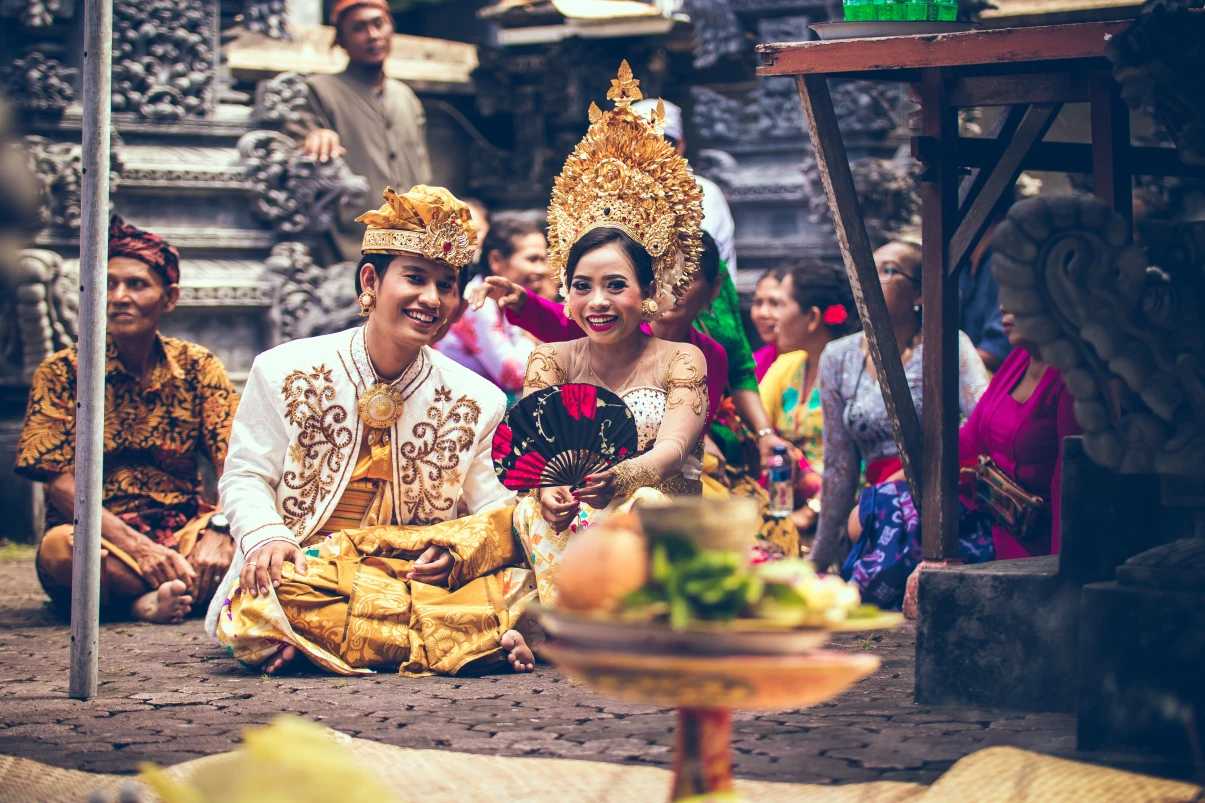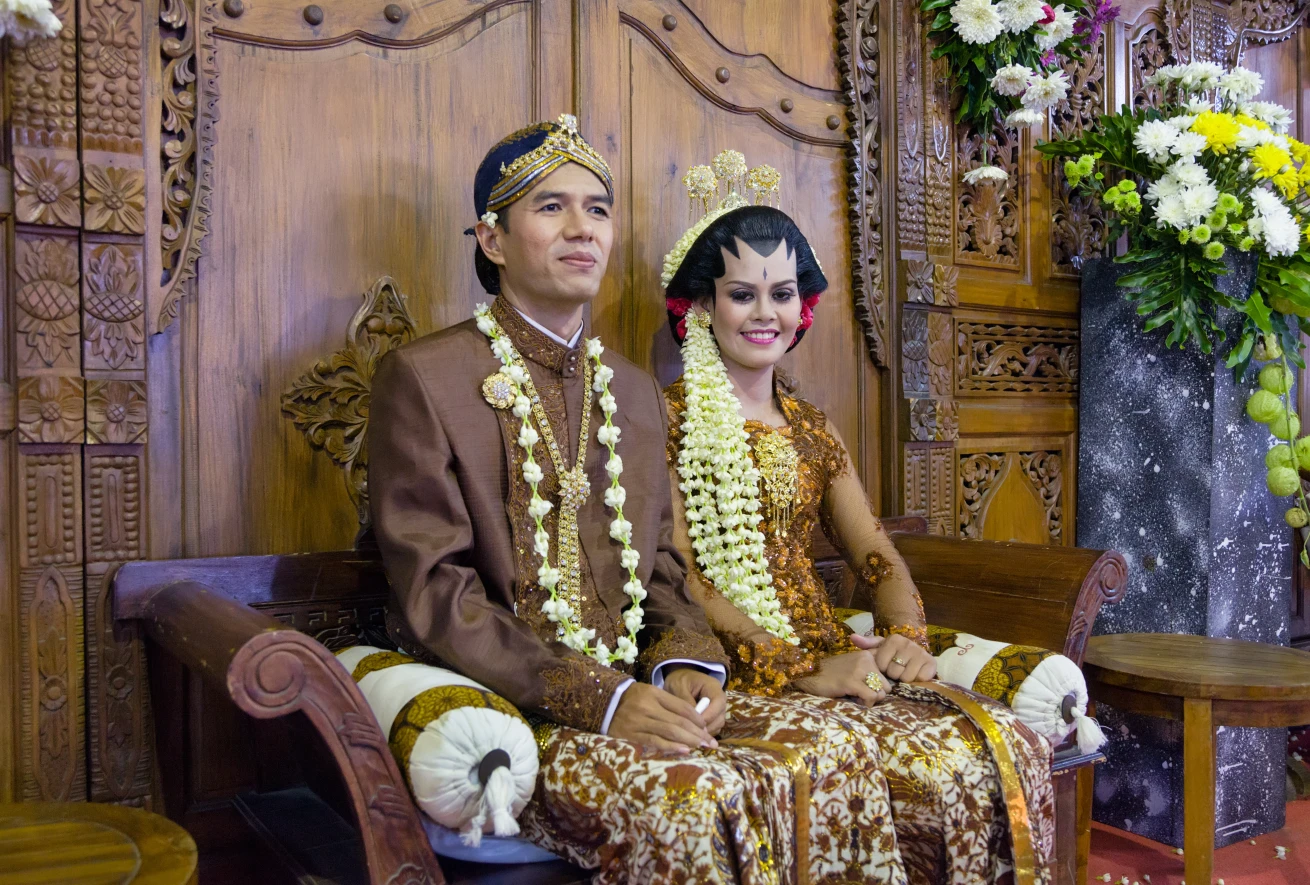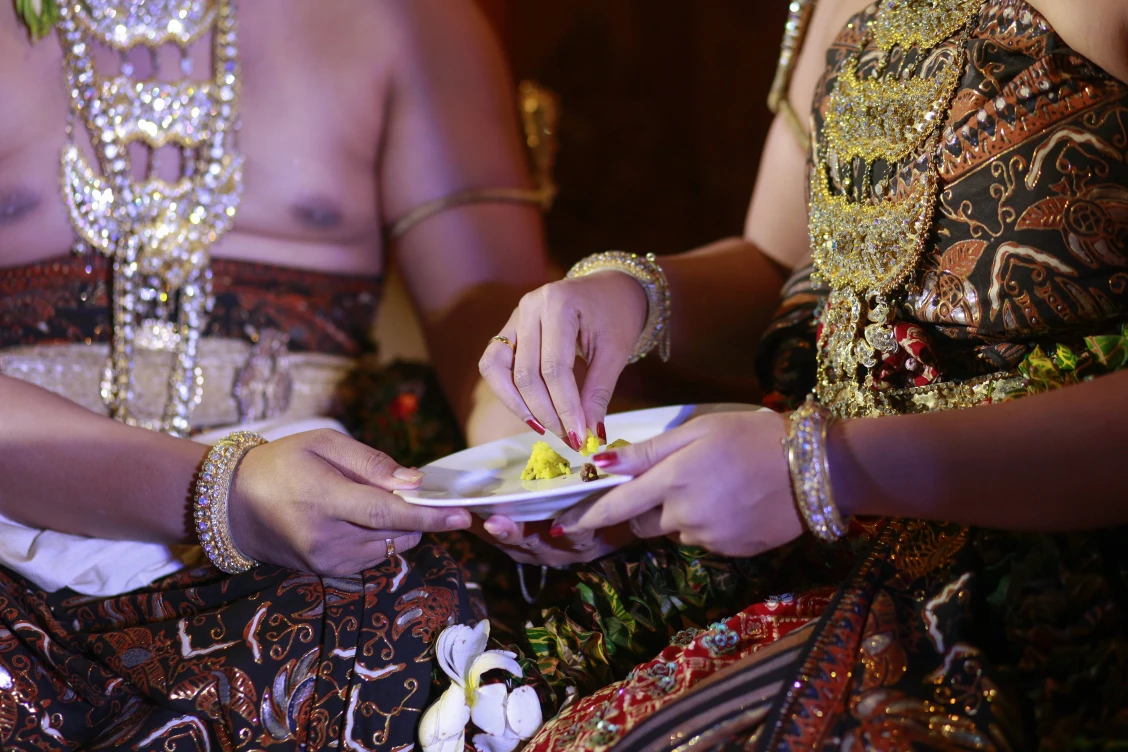Wedding! When we hear this word, warm feelings, smiles, often come to mind. In our imagination, something magical, joyful is envisioned.

Each country has its own traditions and customs for conducting marriage ceremonies. In different parts of Indonesia, wedding rituals can be strange in some places and touching in others, but they are all carried out depending on the rules of each region. Conducting weddings with elements of each regional custom, for example, a traditional Javanese wedding, is a way of preserving and transmitting Indonesian culture from generation to generation.
Let's take a look into the history of Indonesia and explore several different cities in the country where traditions stand out against those of other countries.
History
For centuries, weddings have been a sacred union for the people of Indonesia, approached with responsibility, with preparations beginning long before the celebration.
Central Java
In Javanese culture, there's an ancient tradition called "pingitan" or "pertapaan," whereby the bride is not allowed to leave the house or see the groom before the wedding. Javanese believe this strengthens the couple's feelings, causing the groom to long for and desire the bride even more.
Another explanation for such rules is to prevent any harm to the lovers during outings and other events before the wedding.
Even earlier, a local Javanese who participated in this old traditional wedding as a child told a funny custom. One day before the wedding, neighboring children living near the bride's house had to buy unusual ice cream called "es dawet." They were instructed to find broken tiles or roof tiles, and these fragments from the houses were used as money to buy "es dawet" - a drink made from herbal jelly of different colors, coconut milk, and small pieces of jackfruit. Then ice was added. The children enjoyed the drink and rejoiced. This was a sign that future spouses should help each other in building and maintaining their household. Over time, this custom faded away and is not used nowadays.
Many families hold weddings simply, in the courtyard of their own home, where they set up tents, chairs for guests, decorate the walls with bright fabrics, and prepare food. They even block the road, arranging many chairs for visitors, not allowing motorcycles or cars to pass. Weddings in Indonesia always attract the attention of neighbors, passersby, with their bright, vibrant fabrics, clothing, and loud music.
West Sumatra
There is a region in Indonesia that adheres to a matriarchal system - West Sumatra. The main descendants are considered along the female line. Therefore, the dowry and everything necessary for the wedding are provided by the family of the future wife. It's as if the woman is buying the man.
The family of the prospective bride visits the home of the prospective groom and expresses their desire to marry. If both sides agree, they exchange family relics, gifts, which serve as a symbol of reunion. Later, they bring each other food and fruits to show generosity and consent. Currently, arranged marriages and customs continue, similar to those of the past.
The stages of such wedding customs are roughly as follows:
1. Visiting the family.
2. Communication and exchange of relics.
3. Request for consent.
4. Presentation of gifts.
5. Fingernail rubbing of the bride.
6. Meeting with the groom at the bride's house.
7. Celebration, singing, and lots of Indonesian food.
Sinamot - in Batak culture
In this province, there is a procession called Sinamot, during which the size of the dowry is discussed, depending on the woman's social status, level of education, and career achievements.
For example, if the future bride has a high level of education, then the dowry is valued highly. For the man, a necessary criterion is also higher education and a prestigious job, which ensures a comfortable life for the new family.
However, such discussions are not limited to questions of the material side. Elders of the family share ways to avoid failure and divorce, taking into account the costliness of the planned wedding.
Advice for the young family included the following:
- Open communication with honesty and attention.
- Preserving loyalty and trust.
- Respecting each other, even if there are differences in opinions and desires.
- Solving problems together as a team, without blaming each other.
- Showing care for each other, so that each feels needed and loved.
Wisdom from experienced elders strengthens the marriage.
Tradition - Sawer Sunda
Sawer Sunda - means water falling from the edge of the roof. The ceremony begins with singing spiritual verses with valuable virtues. Later, bowls of rice, coins, turmeric, and sweets are presented to the groom and bride.
Coins symbolize material well-being.
Rice - prosperity and wealth.
Sweets imply a sweet life together.
Turmeric symbolizes fame and a good reputation.
Also, in the traditional Sunda wedding procession, the groom holds 7 sticks, which his wife ignites. Then he puts each burning stick into a pitcher of water to extinguish the fire, remembering to break and discard it. This ritual symbolizes fiery anger, which can only be extinguished by the gentleness and kindness of the wife.
Island of Lombok
In the Sasak tribe on the island of Lombok, there is a wedding tradition of "bride kidnapping," where the groom steals the bride and keeps her in his parents' home. But if he is caught in the process of eloping with the girl, he must pay a fine. In case of a successful "kidnapping," the groom announces that the bride apparently eloped due to love. The groom asks the families to arrange the marriage.
Yogyakarta
In Yogyakarta, there is a custom of testing the strength of relationships. Several days before the wedding, the groom lives in the bride's house so they can get used to each other, thus trying to prevent divorce. Since they were not acquainted before and are being united by their parents' agreement, the future newlyweds are carefully monitored. Someone from the family or neighbors keeps an eye on them to ensure they are not left alone.
Balinese Wedding
A traditional wedding in Bali is somewhat similar to a Javanese one. Both sides of the future spouses choose matching color combinations in their attire, in the fabrics attached to the walls. Families inform guests and friends to dress according to their wishes.
The house is decorated in a tone similar to the chosen attire. At the beginning of the ceremony, bells are rung, and the groom's family enters the bride's home. Relatives bring in beautiful glass boxes with gifts, baskets of food. Later, the bride and groom enter the house, sit on the floor, and are surrounded by many elders. Rituals with prayers are performed, and the spouses share their plans for marriage. After that, the husband and wife listen to advice on how to strengthen their relationship.
What gifts are given at a Balinese wedding? In beautiful boxes, the groom presents, for example, shoes, a bag, traditional clothing, accessories to the bride.
After the rituals and prayers, finally, the buffet is served. Invited guests line up to take food and enjoy the delicacies.
The food is not particularly festive, as one might imagine.
One of the many menu items is approximately as follows: rice, mi goreng (fried vermicelli), satay (small skewers grilled over fire), fried tempeh (fermented soybeans), vegetable soup, and of course, chili sauce.
After the feast, everyone goes to the groom's house, where many guests are already seated at tables and await the celebration. Wedding rituals and prayers are conducted again, followed by enjoyment of Indonesian food. In the evening, loud music and songs play.
Small Regions and Villages
In other small villages, there are many invented traditions that also evoke affection and smiles.
For example, in West Java, the parents of the bride sprinkle the heads of the newlyweds with straw or old coconut leaves. This simple ritual symbolizes the parents' hope that the new family will live in fidelity and harmony until old age.
In Banjarmasin, the bride and groom must sit on the shoulders of dancers. This noisy procession is accompanied by dancing and loud music.
In the city of Mandailing, there is a tradition where the bride must perform a farewell dance called tor-tor at the end of the wedding procession, signifying her departure from her parental home.
The ceremony in Minahasa involves the groom presenting white flowers consisting of 9 stems, 9 flowers, and 9 unopened buds. The number 9 symbolizes complete happiness for them.
In Banjar, there is the tradition of Badudus, where elderly female relatives bathe the newlyweds in orange juice, coconut water, and flowers. The ritual symbolizes success in everything. Pregnant women also assist in this bathing, hoping to achieve success, ward off all bad things, and ease future childbirth.
In the Bajau tribe, there are no strict requirements regarding an expensive dowry. It is enough for the groom to give the bride a white cloth as a symbol of purity. Since the locals live close to the ocean, they take the groom to his beloved by boat.
In some areas of Indonesia, there is a very unhealthy tradition. The bride and groom are not allowed to use the toilet for three days and three nights before the wedding. Families carefully monitor this to avoid breaking the rule. This strange test signifies that the couple will live in wealth and harmony.
Main Preparations for the Newlyweds
In terms of common habits and customs across all regions of Indonesia, the main aspects are clothing, decorations, music, and food.
Clothing
For the sisters and relatives of the newlyweds, matching dresses in the same color are meticulously sewn in a tailor's workshop. The family orders beautiful fabrics with lurex, sequins, and transparent materials to ensure they look festive and, as they say in Indonesian, "mewah," very luxurious. The color coordination extends beyond clothing to match the curtains and wall fabrics.
Decoration
The hall and yard are decorated lavishly and brightly. There are many fresh flowers, beautiful decorations, and curtains made from golden, shiny materials. The walls are draped with velvet or shiny fabric. The colors of the fabrics, curtains, tablecloths, and similar items should partially match the wedding attire of the newlyweds and the outfits of their family, bridesmaids, and women welcoming guests. The floors are covered with beautiful, colorful carpets. The decor considers not only the color scheme but also the type of fabrics.
Music
A small stage is erected in the middle of the hall, with musical instruments and speakers set up. Invited singers perform songs, and even guests can sing.
Food
Guests are often given gift boxes with fresh food, accompanied by a card with the names of the husband and wife. Besides the guests at the wedding, the newlyweds later treat their neighbors with food and gifts in beautiful packaging. Often, food is prepared in large pots, with plates and spoons set up near the tables for the guests.
Wedding Ceremony Guests
Any passerby or even a tourist walking by the wedding procession can unexpectedly join the celebration. Such weddings can host thousands of people, many of whom are not particularly familiar with the newlyweds' family.
These temporary guests simply congratulate the new family on their wedding, receive a small souvenir, a box of food, and leave. This is quite unusual, as typically guests bring gifts for the newlyweds.
Gifts
In modern Indonesia, there is still a custom where guests, relatives, and friends also give gifts to the newlyweds. Mostly, these gifts are money in envelopes, but there are also souvenirs that will be useful in family life:
- Bath and shower accessories: towels, soap, and similar items.
- Bed linen.
- Blender, mixer, coffee maker.
- Music speaker.
- Vacuum cleaner, iron.
- Decorative pillows, table lamp, indoor plants.
- Interior accessories: aromatherapy lamp, miniature figurines, wall clock, photo frames.
Often, a long line of well-wishers forms, so the bride and groom need a lot of patience and strength to stand and receive congratulations from hundreds of guests. Additionally, taking photos with all the guests is an important and popular aspect of modern Indonesian weddings. The photo session can last for hours.
To attract attention and invite guests to the event, music is played incredibly loudly. The host shouts something funny into the microphone, asks questions, creating a festive and humorous atmosphere. People hear the fun and gather around.
The loud sounds continue until the evening. For the locals, this is normal. For foreigners, such noisy weddings may seem strange and exhausting. They may not last long at such a celebration—ears turn inside out after just a few minutes of being there!
Finally, let's delve into the Indonesian customs for the main people of the wedding celebration.
The bride and groom

In Java, one of the elements of the bride's wedding makeup is paes. The makeup consists of black indentations on the bride's forehead, which have deep significance. Paes is traditional Javanese wedding makeup that symbolizes the beauty and maturity of a Javanese woman. The makeup, with its triangular smooth indentations, holds sacred and philosophical meaning in each detail.
These figures represent hope and prayers for the bride's and her family's future. An indentation shaped like the rounded end of a duck egg signifies that the woman will be elevated and respected, and that the bride and groom will become an ideal couple.
The indentation adorning the sideburns is called hodheg. It means that the bride and groom will always engage in self-reflection and make decisions without haste and with wisdom.
To embellish the paes, a cithak is placed in the middle of the forehead. This diamond-shaped decoration shows a focus on devotion in marriage.
The newlyweds look elegant and striking. "In traditional weddings, the bride and groom usually stand out with paes and kebaya.
Some weddings feature very unusual attire, with partially exposed body parts adorned with beautiful belts, garlands, and fabrics.

In very wealthy families, the bride often dresses in attire resembling that of a queen. In a luxurious dress and a huge crown, she looks stunning. However, one might wonder: how does she endure the weight of the crown? Additionally, she strives to smile all day, to be joyful, happy, and patiently receive a sea of guests. Indeed, love works wonders and provides strength!
Regardless of the traditions or customs of the people, one thing is clear: worldwide, the business of conducting wedding ceremonies has turned this event into a massive industry. Enormous funds are invested in this celebration. Of course, it is understandable that a wedding is a special event, and people want to make it memorable, with family customs and impressions to look back on and cherish through wedding photos.
But, above all, it is important to understand the significance of this day and be ready to fulfill the roles of husband and wife, supporting each other in any circumstances. Only then can one be confident that a solid foundation for a happy and long-lasting marriage is being laid.
You can add one right now!